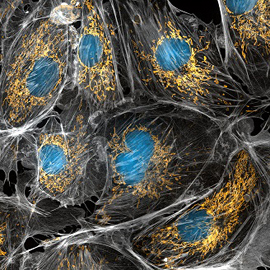Study reveals potential candidates for diagnosing mitochondrial diseases
Energy production in mitochondria—structures within cells that produce energy from oxygen and nutrients—relies on a group of proteins previously not linked to this process, according to a study led by researchers at the National Institutes of Health. The findings may help researchers identify gene mutations that lead to defective mitochondria, which underlie several diseases. The study was published in the April 4, 2017, issue of Cell Metabolism.

Background
Mitochondria are rod-shaped structures that generate most of the energy the body needs. When mitochondria fail, organ systems can fail. The brain, heart, lungs, and muscles require the greatest amounts of energy and so are most affected by mitochondrial problems.
Mitochondrial diseases occur in children and adults and affect each individual differently. Symptoms can include mild to severe developmental delays, as well as problems walking, talking, seeing, and digesting food.
Within the inner mitochondria membrane, five protein complexes (called Complex I-V) carry out chemical reactions that drive energy production. The complexes generate energy by creating a difference in electrical charge. To create this difference, the complexes need iron-sulfur clusters. However, before the current study, researchers did not understand how iron-sulfur clusters reach their destination.
Results
Researchers led by Tracey Rouault, M.D., of NIH’s Eunice Kennedy Shriver National Institute of Child Health and Human Development, studied the delivery of iron-sulfur clusters to Complex III, which requires iron-sulfur clusters at a specific part called the Rieske iron-sulfur protein.
Through a series of experiments in human cell cultures, the team found that a group of proteins made up of HSC20, HSPA9, and ISCU help bring iron-sulfur clusters to the Rieske iron-sulfur protein. Furthermore, they found that HSC20 also delivers iron-sulfur clusters to Complex I and II. The researchers suspect that HSC20 may deliver iron-sulfur clusters to a range of proteins, although more work is needed to confirm this idea.
Significance
The study identifies key components needed for mitochondrial energy production.
“Mitochondrial diseases can be difficult to diagnose because symptoms vary between individuals and can involve multiple organ systems,” said Dr. Rouault. “Our findings reveal additional genes that, if confirmed with future studies, could be used to diagnose a suspected mitochondrial disorder.”
Reference
Maio N, Kim KS, Singh A, and Rouault TA. A single adaptable cochaperone-scaffold complex delivers nascent iron-sulfur clusters to mammalian respiratory chain complexes I–III. Cell Metabolism DOI: 10.1016/j.cmet.2017.03.010 (2017).

 BACK TO TOP
BACK TO TOP